A case study of a Black Friday retail campaign
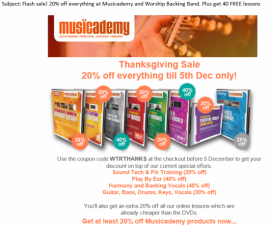
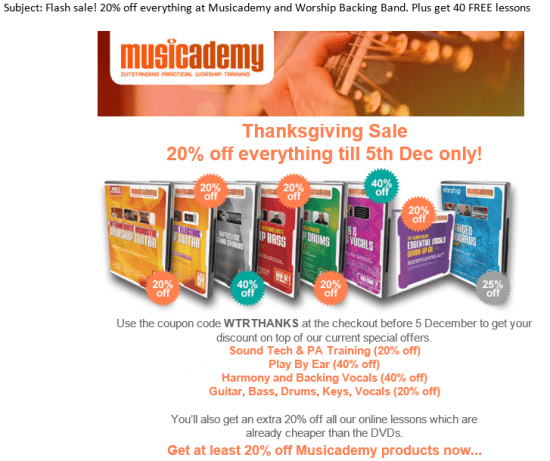
An integrated small business campaign example
I awoke on the last Friday of November to the usual Black Friday hangover. On checking my emails I was inundated an avalanche of offers in relation to that American import which, like Halloween, is now huge over here in the UK too: Black Friday. With the Argos, Currys, Tesco and Boots’ websites all experiencing outages due to weight of demand, the British public appears to have got over its aversion to this American celebratory holiday of all things consumer.
I run a niche ecommerce business that has a big US subscriber base, and based on previous Thanksgiving weekends it was clear that we needed to have a planned approach to the “holiday” season. As the day drew nearer we had customers emailing asking what we had planned as offers – it was going to be a big sales day.
Now we are a small business, our turnover isn’t huge but we are the market leader in our sector worldwide. I have access to a designer and I run the website, email marketing and social media myself. I do also consult extensively in said fields (I wear a number of hats as well as running Musicademy) so I am also our in-house expert but the point here is that we’re not working with a specialist agency. This is in-house DIY internet marketing so accessible to any marketer with a bit of digital savvy hence why I want to share what is quite a lengthy post with you.
What to offer on Black Friday?
The big retailers Asda (well they are owned by Walmart), Tesco, Amazon, John Lewis et al. all led with targeted big discounts including the aforementioned flat screen TVs. We have previously done spot sales on particular items but we’ve also tested blanket discounts across the entire webstore and have found average order value considerably higher as a result.
So we went for a 20% blanket discount off every product. With some of the existing sales and offers (we already reward bulk buyers) this represented a significant saving on RRP for many products.
Messaging
I like to think that people buy from people, not websites so we decided to go with a personal “With love and thanks from us to you” message which focussed on “Thanksgiving”. We incorporated a “Thanks for subscribing to our updates” message and chose “THANKFUL” as our coupon code. We genuinely feel that way about our customers, and we also felt that this approach would go down well with our North American Christian market.
We have a sister company, Worship Backing Band, that targets a very similar audience so a similar campaign was also created for that.
Design
We stuck with a variant of the design style we’ve been evolving in recent months which reflects our corporate colours and other key elements. We have two image styles we tend to work with – one is a white silhouette of the different instruments we teach and the other is a series of pack shots. I wanted to use this campaign to test the effectiveness of each of these, and also to enable a variety of images across different platforms.
We tend to use a tinted image in the background of a lot of our ads so for these we chose some pumpkins – again reflecting the Thanksgiving occasion.
Choice of platform
In keeping with most ecommerce retailers email marketing is our normal workhorse channel so a Thanksgiving email duly made its way out at 8am on the morning of Black Friday to our 27,000 subscribers.
We also booked in third party emails with two partner organisations. One a big magazine which we’ve used extensively in the past with great results (we actually write a regular column in the magazine so their customer base is well aware of us) and the other with a specialist forum with a decent mailing list (with this one we offered a reciprocal deal and had sent out an email to our list over the summer that had featured their site).
In retrospect I think the masthead here (in the partner email) was wrong – we should have stuck with the Thanksgiving image.
The website home page featured the Black Friday offer and a blog post (see below) was made live. This would also be useful for social sharing later. As people are now on-site the image shifted to pack shots.
Facebook marketing
As anyone will know that has read my previous posts here, I’m a power user of Facebook both as an organic platform and for targeted ads. In previous years we’ve trailed our Black Friday offers with teasers but for a number of reasons elected not to do that this year (it is a good approach though).
My Facebook strategy was fairly complex. I knew that organic reach levels on what are quite promotional messages would be low so advertising was going to be essential. I therefore created a logical but complex campaign as follows:
Facebook targets
At Ad Set level I created an approach that targeted some distinct segments (all of which had been tested and proven in previous campaigns)
- Exisiting fanbase
- Existing mailing list using the website custom audience tool
- People that “Like” relevant other brands
- Lookalike audience (using the custom audience tool again these were lookalikes of my mailing list – they equally could have been fan lookalikes)
- And of course Facebook will often surface messages about new likes and shares of ads to friends’ newsfeeds
- Age and geographic location (UK, US and Canada) was layered on every ad in order to focus our targeting at those individuals more likely to respond
Facebook positioning and pricing
I know from recent testing with the targets above that right hand ads just aren’t working for us so I opted for desktop newsfeed and mobile newsfeed. Again as a result of testing I know that CPC works better for us so I initially set the ads up to that with the intention of shifting to OCPM if Facebook wasn’t playing ball by showing the ads (this does happen sometimes, even with ads with good CTR, and I anticipated a huge demand on newsfeed ad space over the Thanksgiving weekend). See this graphic from SocialCode which (as Jon Loomer points out in an intelligent article on why Facebook holiday ads fail) shows that it cost x2.58 more to show an ad to 1,000 people on Black Friday.
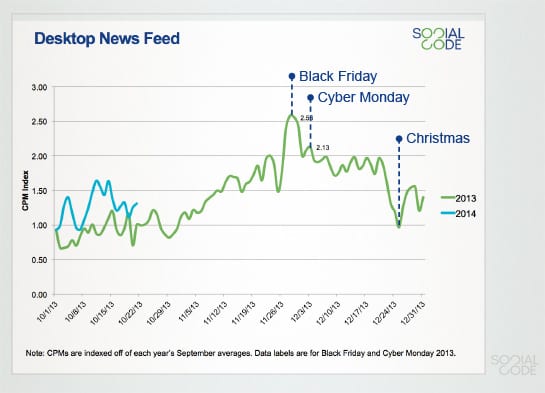
Incidentally, if you are allocating budget to desktop vs mobile newsfeed I’d suggest something like a 70/30 split in favour of mobile. Mobile ads are really working for us at the moment. And especially in the US at holiday time when people aren’t at their desks, a focus on mobile is essential.
Facebook ad types
Hugely relieved that we don’t have to jump through the faff of unpublished (dark) posts to get the kind of ad I was wanting, I set about creating my ads. These were created earlier in the week and scheduled for the Friday morning. The beauty of these new Power Editor ads is that you can change the copy at any point so from the Saturday onwards these ads lost the “Black Friday Flash Sale” message and instead reverted to “Thanksgiving Weekend” or “Cyber Monday offers” or “Pre Christmas Flash Sale”. Again testing variants is useful.
Here’s an example of one for Worship Backing Band:
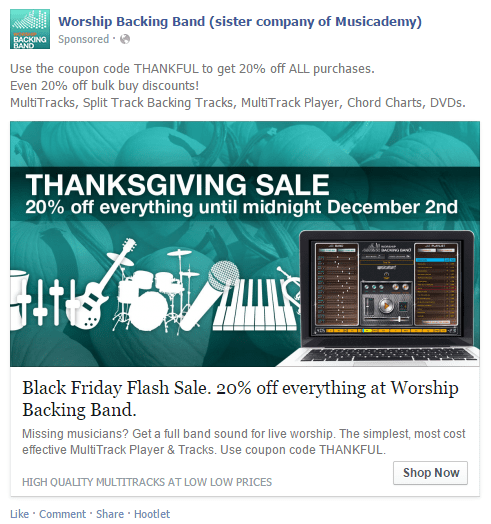
Note the use of a call to action and the different text utilised in the different places on the ad. You only get this level of flexibility by using Power Editor.
With Musicademy I tested two different ad images (see below – both complying with the 20% text rule). Depending on my results mid way through the Friday I could then turn off the one that was least effective.


I also created blog posts with the relevant images and some informative text which were used organically on Facebook as link posts and turned into ads during the weekend. Note that I never use the Boost Post button. Instead I will go into Power Editor and create an ad form that organic post.
Facebook Offers
I LOVE Facebook Offers. They are massively under utilised so are quite a novel item for users in newsfeed. Reach is not too shabby and it’s easy to add a little ad budget to them to further extend their reach. The other very nice thing with Offers is that they are a lot stickier in terms of viral reach because Facebook surfaces messages about offer claims in friends’ newsfeed and also asks the user if, having clicked on the offer, they want to share it.
And the other great thing about Offers is that Facebook emails your offer to those who click on it plus sends another reminder email just before the offer expires. What’s not to like?
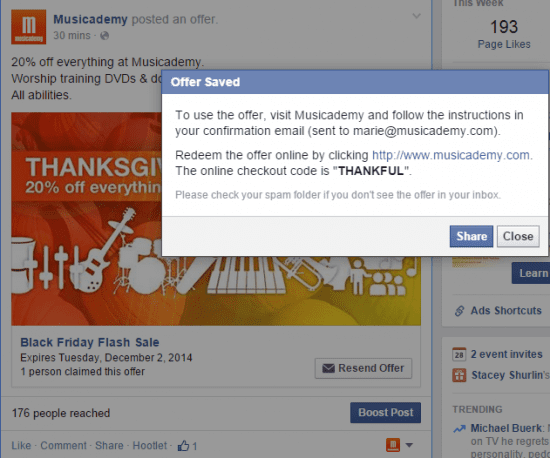
The offer also meant I had something unique to put on the newsfeed at 8am UK time (I know I can target organic posts but geography but people don’t see comments and likes from other terrotories and unfortunately you have to list each recipient country individually).
I created the Offer in Power Editor (effectively as an Unpublished Post) and scheduled the ad for the afternoon of Black Friday. On the actual morning, however, I nipped into the “Manage Pages” area on Power Editor (top left) and “published” the dark post to extract a little organic reach out of it first. The Offers were created using optimised bidding.
The results
The results weren’t exactly what I would have predicted and it felt a lot harder work this year than last. On the positive, we spent about £175 on Facebook ads and had a very healthy boost in sales. Email marketing was the most effective medium (particularly to our own mailing list).
The UK seemed to have really embraced Black Friday and Cyber Monday with stores reporting record sales. However, in the US the New York Times cited Black Friday Fatigue as responsible for an 11% decline in sales since last year. Other possible factors cited were the residual effects of recession, deep discounts in the run up to Thanksgiving and the conditioning effect of continual sales leaving shoppers holding out for even better offers. We certainly saw plenty of that. Despite a bigger advertising push than last year, our sales were a fair bit lower (the majority of our customer base is in the US). And despite a near identical offer to last year, it felt from emails had a lacklustre response, as if customers were wanting something more.
Firstly, there was clearly a lot of competition on newsfeed over the entire period so I went in on the Friday morning and upped my bid price on all ads. This worked to increase my paid reach to more acceptable levels.
My A/B split test showed a clear winner in CTR and conversion (the silhouette image rather than the pack shots) so the loser ads were switched off.
My organic posts got very poor reach. I wasn’t entirely surprised to see this. Firstly they are promotional (and I suspect that the algorithm was adjusted down for words like “Sale” “Black Friday” and other discount indicators). Secondly, whilst we have plenty of paying customers, our marketing emphasis is that of delivering great content. Reach of good quality posts is often over 35% and often well above that but I’ve never found that posts about products get many clicks or likes and the viral reach of them is virtually zero. Similarly the open rate on the email was much lower than our usual content driven weekly newsletter. I’m sure as well that a good proportion of people were simply sick of all the promotional messages being bombarded at them over the weekend.
Also we know that Facebook dislikes multiple uses of the same image. So once the images were out in one format (say an ad or offer), organic posts using the same image would suffer from poor reach. This is useful learning for the future – when you are using an image in an ad, make sure you create something different for organic posts. And the beauty of this approach is that your organic posts can have as much text on the image as you like (although arguably Facebook isn’t keen on images with lots of copy – certainly penalises any it thinks are meme like).
In terms of audience, our Lookalike audiences worked really well for CTR and conversion. We’ll definitely continue to craft ads for them in the future. We’d expect fans to respond and they did, but mainly in response to email marketing. I suspect that the Facebook ads merely acted as a reminder to them (perhaps when they were on mobile and out and about) and when back to desktop settled down with the email to make their sale purchases.
The initial Musicademy Offer got some good traction (34 offer claims from a Reach of 6,276 and spend of £40) so I decided to re-work the idea on Cyber Monday for the Worship Backing Band brand. Again I created an unpublished page post offer, made it live on the Page then scheduled the Offer Ad for a few hours later.
Here’s the Worship Backing Band Offer and the email Facebook sends to those who take it up:
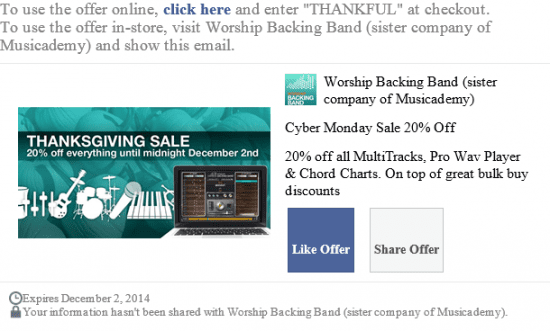
(Don’t you just hate Facebook’s default typeface and styling of this message?)
Customer reaction
There was the inevitable set of moaning from British customers about why we (as a UK brand) were embracing this American import and bowing to the gods of consumerism. It was great to see British fans coming to our rescue without us having to justify our actions (see a snippet from the conversation below).

We also had the odd email from people miffed that they’d purchased at full price a few days before (we sent them some free stuff as a consolation and to our delight they ended up buying even more). One emailer told us we were being tight at only offering 20%. I didn’t see many retailers being that generous across their ENTIRE RANGE (including titles that had only been released a few weeks previously). On reflection I think we could have played the game most retailers do in sales and simply cherry pick a few key products (many of which were already on half price sale) and slash the price dramatically to get the headline effect. But much of our objective was to increase average order value which a blanket discount offer had previously achieved.
Again we were able to counter this a little with our Cyber Monday email where we hit hard on the messaging to do with additional in-store discounts. The headline read “Did you think our 20% off Black Friday coupon wasn’t generous enough?”
In terms of purchases the Cyber Monday email was twice as effective as that of Black Friday but do remember that it may also have served as s useful reminder to those that may still have been waiting to act on the Friday email.
So lessons learned for the future.
Reflections
Responsiveness was crucial throughout the campaign. Sure the ads and organic posts were scheduled but we benefited from me dipping in and tweaking copy, bids and targeting based on what real time results were telling me. I was also learning over the weekend from customer reaction, what other brands were doing and how the algorithm was working – all this informed the content I created for the last big push that was Cyber Monday.
This has also given us a glimpse of the future for promotional posts. Facebook is very much Pay To Play unless you have non-promotional content but with a clever use of budget (and for clever read putting in the hours researching, testing and setting up ads) you can get good results on very small budgets.
Comparing what I paid for the third party email list and Facebook ads I’d choose the ads every time. And I will continue to invest in building our own list organically and focus on serving them great quality content, building up trust and permission to occasionally talk to them about products. Pretty much the same way I feel about my Facebook newsfeed.
From our sponsors: A case study of a Black Friday retail campaign



